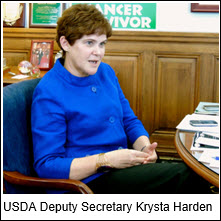WASHINGTON, Sept 2, 2015 - USDA is rolling out the Whole-Farm Revenue Protection (WFRP) program across the country next year despite the fact that not a whole lot of people took advantage of it during this year’s pilot offering.
WFRP is designed to cover all produced commodities under a single policy, something that could benefit smaller organic and specialty crop producers. The program will be available in every county in the country in the 2016 crop insurance year, also paving the way for potential urban agriculture involvement as well.
In an interview with Agri-Pulse, USDA Deputy Secretary Krysta Harden referred to the program as “another tool in the toolbox” for producers. “We’re really hoping to ramp it up and get folks interested and recognize the benefits of this to their operations,” Harden said.
In the 2015 pilot project, the program enlisted only 1,134 policies through late August, just .05 percent of USDA’s almost 2.24 million total crop insurance policies sold in 2015, according to the department’s Risk Management Agency. Previous variations of “whole farm” plans, like Adjusted Gross Revenue - which was launched in 1999 - have also failed to gain traction on a national basis.
Harden said some of the low participation in this pilot program can be explained by the uncharted nature of the program.
 “It was new; folks were a little nervous about it,” Harden said. “They said they wanted it, but then it was so new that they didn’t know if they wanted to actually buy it.”
“It was new; folks were a little nervous about it,” Harden said. “They said they wanted it, but then it was so new that they didn’t know if they wanted to actually buy it.”
The program has also undergone slight modification since its pilot stage, Harden said. Changes include shifting the records requirement from five to three years and opening up the program to operations with larger livestock production than allowed in the pilot program. She said the alterations make the program available to more new and beginning farmers as well as broaden the scope of potential WFRP enrollees.
USDA’s willingness to adapt the program based on consumer and industry feedback was cheered by Laura Batcha, CEO of the Organic Trade Association. In a statement, Batcha said the program’s changes “will increase access to the crop insurance program and improve insurance coverage for beginning farmers, diversified crop producers, recently-transitioned farmers and livestock ranchers.” She added that the changes are “another important step to provide better and more equitable protection for organic farmers and livestock producers.
Much of the discussion around the program has dealt with smaller specialty crop and organic operations, including some of the language on the RMA webpage detailing WFRP. But it is technically open to any operation with multiple crops and up to $8.5 million in insured revenue, including less than $1 million in animals and animal products.
Moving forward, Harden said it’s hard to predict producer enrollment in the program, but said that she will check at this time next year and “see if the improvements were actually enough or are there other tweaks that need to be made.”
Harden urges producers to discuss WFRP with their crop insurance agents to see if the program works for them, stressing that no USDA program is a one-size-fits all approach.
“You need somebody to sit down, back of the envelope, whatever it might be, around your kitchen table,” Harden said. “Pencil out – does this make sense for you?”

